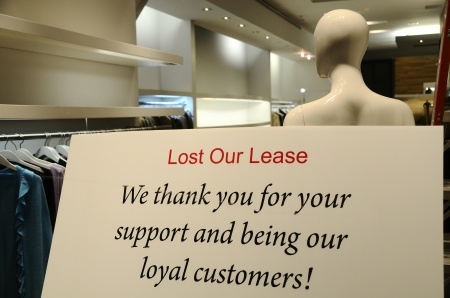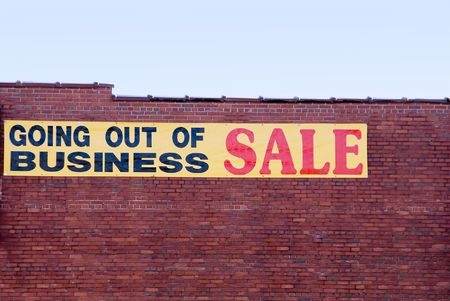Small Business
Would You Fund This Business?
April 12, 2014 Is the site inspection dead?
Is the site inspection dead?
One of the strangest byproducts of the automation age is that underwriting tools once deemed absolutely essential are being replaced with APIs, digital verifications, and algorithmic scoring. Speed is everything, but why?
Faster speed through automation allows for scaleability. The promise of speed to a potential customer also encourages them to apply. Working capital can be an impulse decision now. You don’t even need to leave your chair to get $80,000 for your small business. But who’s making sure these businesses are sound… or more importantly, that they even exist?
I learned through conversations at Transact 14 that there is a growing dependency on Google Earth for site verification, more specifically Street View. Really??? Street View?!
While tech heavy funding companies laud real-time data through hundreds of APIs, it’s amusing to think that something like Street View, which might not be updated for months or years at a time, suffices as a site verification. Indeed, Street View still shows Christmas decorations in my home town.
Google Earth can pinpoint the obvious things like showing you something is located in the middle of nowhere:

But can it show you this sign located inside?

And how would you know if the writing was literally on the wall if it just went up yesterday?

Or that everything is completely on the up and up except that the business will be:

If you had the chance to speak with Jason Fullen or Joe Volk at NVMS during Transact 14, you’d know that site inspections performed by real live humans can be done in the same day they’re ordered. Or if you were getting wild at the Quiktrak party, you’d know that many of the older merchant cash advance companies still rely on site inspections, particularly on large deals.
How dumb would you feel if the $150,000 deal you funded looked like this on the inside?

Investigate a little
Who better to know the scoop on the business than the locals? I am reminded of the time a $100,000 deal I worked on where the site inspector commented that a restaurant was actually a front for a brothel that was likely going to get shut down.
I also recall almost funding a $100,000+ supermarket until the site inspection revealed that all of the shelves in the store were empty. I guess that merchant wasn’t lying when they said they needed the money to buy inventory!
And there was my own personal trip to a Brazilian Steakhouse for the final approval on an MCA deal based on credit card transactions. The server politely informed me at the end of my meal that the establishment no longer accepted credit cards as of a few days ago. How convenient…
Can social media be our eyes?
In the social media era, it’s almost as if a million site inspections are being conducted every minute. Can reviewer data be our eyes?



If there are too few reviews or they’re aged, can you rely on all your other data points? Can you trust that the available reviews are from real customers?
Speed is king these days, but ignorance is never in style. One has to consider if they can trust external data versus what they see with their own two eyes. We’ve all seen deals that looked great on paper, but turned out to be complete

After further review of the deal:

Should we fund businesses we never see? It’s your call.
Merchant Cash Advance Syndication: Crowdfunding?
March 28, 2014 You might not have known this, but one of the most lucrative opportunities in merchant cash advance is the ability to participate in deals. It’s a phenomenon Paul A. Rianda, Esq addressed in DailyFunder’s March/April issue with his piece, So You Want to Participate?
You might not have known this, but one of the most lucrative opportunities in merchant cash advance is the ability to participate in deals. It’s a phenomenon Paul A. Rianda, Esq addressed in DailyFunder’s March/April issue with his piece, So You Want to Participate?
Syndication is industry jargon of course. You probably know the concept by its sexier pop culture name, crowdfunding. For all the shadowy rumors and misinformation that circulates out there about merchant cash advance companies, they’re similar to the trendy financial tech companies that have become darlings of the mainstream media.
Did you know that many merchant cash advances are crowdfunded? To date, no online marketplace has been able to gain traction in the public domain aside from perhaps FundersCloud, so crowdfunding in this industry happens almost entirely behind the scenes. There is so much crowdfunding taking place that it’s becoming something of a novelty for one party to bear 100% of the risk in a merchant cash advance transaction. Big broker shops chip in their own funds as do underwriters, account reps, specialty finance firms, hedge funds, lenders, and even friends and family members of the aforementioned.
Merchant cash advance companies find themselves playing the role of servicer quite often, which is coincidentally the model that Lending Club is built on. A $25,000 advance to an auto repair shop could be collectively funded by 10 parties, but serviced by only 1. Each participant is referred to as a syndicate. This is not quite the same system as peer-to-peer lending because syndicates are not random strangers. Syndication is typically only open to businesses, and most often ones that are familiar with the transaction such as the company brokering the deal itself.
In the immediate aftermath of the ’08-’09 financial crisis, some merchant cash advance companies became very mistrusting of brokers and deal pipelines were going nowhere. Underwriters had a list of solid rebuttals for deals they weren’t comfortable with. “If you want us to approve this deal so bad, why don’t you fund it yourself!,” underwriters would say. Such language was intended to put a broker’s objections over a declined deal to bed. But with all the money being spent to originate these deals, it wasn’t long until brokers stumbled upon a solution to put anxious merchant cash advance companies at ease. “Fund it myself? I’d love to, but I just can’t put up ALL of the cash.”
And so some brokers started off by reinvesting their commissions into the deals they made happen. That earned them a nice return, which in turn got reinvested into additional deals. Fast forward a few years later and deals are being parceled out by the truckload to brokers, underwriters, investors, lenders, and friends. There’s a lot of money to be made in commissions but anybody who’s anybody in this business has a syndication portfolio. The appetite for it is heavy. Wealthy individuals and investors spend their days cold calling merchant cash advance companies, brokers, and even me, trying to get their money into these deals. They know the ROI is high and they want in.
 That’s the interesting twist about crowdfunding in the merchant cash advance industry. You can’t get in on it unless you know somebody. There are no online exchanges for anonymous investors to sign up and pay in. It requires back door meetings, contracts, and typically advice from sound legal counsel. A certain level of business acumen and financial prowess are needed to be considered. These transactions are fraught with risk.
That’s the interesting twist about crowdfunding in the merchant cash advance industry. You can’t get in on it unless you know somebody. There are no online exchanges for anonymous investors to sign up and pay in. It requires back door meetings, contracts, and typically advice from sound legal counsel. A certain level of business acumen and financial prowess are needed to be considered. These transactions are fraught with risk.
In Lending Club’s peer-to-peer model, investors can participate in a “note” with an investment as small as $25. This is a world apart from merchant cash advance where it is commonplace to contribute a minimum of $500 per deal but can range up to well over $100,000.
Lending Club defines diversification as the possession of more than 100 notes. At $25 a pop, an investor would only need to spend $2,500. With merchant cash advance, 100 deals could be $50,000 or $10,000,000. By that measure, syndication is crowdfunding at the grownup’s table, a table that doesn’t care about sexy labels to appease silicon valley, only yield.
Strange merchant cash advance jargon keeps the industry shrouded in mystery. Did you know that split-funding and split-processing are terms often used interchangeably? Or that they have a different meaning than splitting? Or that the split refers to something else entirely?
Do you know what a holdback is or a withhold? How about a stack, a 2nd, a grasshopper, an ISO, an ACH deal, a junk, a reup, a batch, a residual, a purchase price, a factor rate, or a UCC lead?
Paul Rianda did a great job detailing the risks of syndication, but there is one thing he left unsaid, and that’s if you’re going to participate in merchant cash advances, you better be able to keep up with the conversation.
At face value, syndication is nothing more than crowdfunding. But if your reup blows up because some random UCC hunting ISO stacked an ACH on top of your split while junking him hard and upping the factor with a shorter turn, you just might curse the hopper that ignored your holdback and did a 2nd. And on that note, perhaps it’s better that the industry refrain from adopting mainstream terminology. We wouldn’t want everybody to think this business is easy. Because it’s not.
One factor to consider is the actual product being crowdfunded. In equity crowfunding, participants pool funds together to buy shares of a business. In crowdlending, participants pool funds together to make a loan. But in merchant cash advance syndication, participants pool capital to purchase future revenues of a business. An assessment is made to predict the pace of future income and a discounted price is paid to the business owner upfront. That purchase price is commonly known as the advance amount.
Syndication has more in common with equity crowdfunding than crowdlending. If you buy future revenues and the business fails, then your purchase becomes worthless. There is typically no recourse against the business owner personally unless they purposely interfere with the revenue stream and breach the agreement. Sound a bit complicated? It is, but crowdfunding in this space is prevalent nonetheless. To get in on it, you need to know someone, and to do it intelligently, you better know what the risks are.
If you want to sit at the grownup’s table and syndicate, consult with an attorney first. There’s a reason this industry hasn’t adopted sexy labels. It isn’t like anything else.
Federal Reserve Examined Alternative Business Lending
March 20, 2014 Back in January, 3 staff members of the Federal Reserve board investigated peer-to-peer (p2p) business lending, particularly by comparing it against p2p consumer lending. It offers this introductory background, “As distrust and dissatisfaction with commercial banks grew during the recent financial crisis,there was large growth in nonstandard types of borrowing arrangements.” That’s usually where we’d segue off into a discussion about merchant cash advance but it was the p2p model that had them so intrigued.
Back in January, 3 staff members of the Federal Reserve board investigated peer-to-peer (p2p) business lending, particularly by comparing it against p2p consumer lending. It offers this introductory background, “As distrust and dissatisfaction with commercial banks grew during the recent financial crisis,there was large growth in nonstandard types of borrowing arrangements.” That’s usually where we’d segue off into a discussion about merchant cash advance but it was the p2p model that had them so intrigued.
As it is a 28 page study, I have pasted the excerpts I felt were most relevant with my comments on top. The link to the full report is at the bottom:
Something I’ve noticed a lot myself:
Small business owners often intermingle their personal and business finances
Something Lending Club might want to think about a day after they announced business loans with an interest rate of 5.9%:
Our results indicate that loans for small business purposes were more than two-and-a-half times more likely to perform poorly.
Do merchant cash advance companies face a similar risk?
Between 2006 and 2008 peer-to-peer lending grew steadily. It hit a snag in 2008 when the SEC determined that their loans should be classified as securities and, thus, regulated. This led both Prosper and Lending Club to put any new loans on hold until they properly registered with the SEC.
Yup.
Lending to small businesses is generally considered to be riskier and more costly because small firms have higher failure rates and are more vulnerable to downturns in the economy. Lending to small businesses is further complicated by their informational opacity. Most do not have the detailed financial statements
Lending Club had higher decline rates in high risk states.
while Florida was home to more than 4,000 applications for small business loans, fewer than 300 of them were funded
We’ve all seen deals where the merchant requests much more than we’d ever feel comfortable with:
requesting greater amounts of money decreased the likelihood of a loan being funded; each additional $1,000 requested decreased the likelihood of funding by about 4 percent.
Rest assured, the government will be watching and measuring the impacts all the while. Do higher cost, low paperwork loans impact small business longevity? I’m reminded of the raging stacking debate taking place in the industry right now…:
As small business owners are increasingly turning to this alternative source of money to fund their businesses, policy makers may wish to keep a close eye on both levels and terms of such lending. Because such loans require less paperwork than traditional loans, they may be considered relatively attractive. However, given the relatively higher rate paid on such loans, it may be in the best interest of the business owner to pursue more formal options. More research is required to understand the long-term impact of such loans on the longevity of the firm and more education to potential borrowers is likely in order.
Is There Cause for Alarm?
March 8, 2014
Brick and mortar chain stores died this week, after a long illness. Born along Main Street, raised in shopping malls across post-World War II America, the traditional store enjoyed decades of good health, wealth and steady growth. But in recent years its fortunes have declined. Survived by Amazon.com and online outfits too numerous to list.
– CNN 3/7/14
Just a day after Jeremy Brown’s new CEO Corner post appeared on DailyFunder with an overt bubble warning, CNN’s Chris Isidore alluded that the era of brick & mortar retail may be drawing to a close. In Isidore’s brief sensational article, he fingers an overabundance of retail space, a weak economy, and the Internet as the culprits behind Main Street‘s decline.
In the broad alternative business lending industry, the sentiment is quite the opposite. Small business demand for working capital is surging and no one is predicting anything less than stellar growth for the foreseeable future. But is the growth real?
Jeremy Brown is the CEO of Bethesda, MD-based RapidAdvance and he explains the growth may not be what it appears to be on the surface. Some cash providers are overpaying commissions, stretching out terms longer than what their risk tolerance supports, and are growing by funding businesses that have already been funded by someone else (a practice known as stacking).
If the industry collectively booked 50,000 deals in 2013 and increased that to 100,000 deals in 2014, you’d have 100% growth, or at least it would appear that way on the surface. What if the additional 50,000 deals funded this year were not new clients but rather additional advances and loans made to existing clients? It’s a lot easier to give all of your clients money twice instead of acquiring new ones.
This all begs the question, is demand for non-bank financing really growing by leaps and bounds? Or does it just appear that way because those that have already utilized it are demanding more of it?
Brown left his readers with this conclusion, “There will be a rebalancing at some point. And it will not be pretty.”
Chime in with your thoughts about this on DailyFunder.
—–
When Will the Bubble Burst? by Jeremy Brown will also appear in the next print issue of DailyFunder. If you haven’t subscribed to the magazine already, you can do so HERE.
What’s the Reason Behind the Rise of Non-bank Financing?
March 6, 2014OnDeck Capital CEO Noah Breslow is no stranger to CNBC. Just as word hit the press that his company had raised another $77 million, he made a television appearance to discuss their success.
So why are small businesses owners turning to alternatives?
Many businesses that use alternatives such as OnDeck qualify for traditional bank financing and use the alternatives anyway. Now that’s something to think about…
How Will Obamacare Affect Small Businesses?
December 12, 2013It’s one thing to assume how small businesses feel about Obamacare and another to hear it straight from the horse’s mouth. New York-based funding provider Merchant Cash and Capital surveyed their clients and this is what they learned:
- Nearly one third of respondents believe the Act will increase operational expenses.
- 40 percent aren’t sure how it will impact their business.
- One in four respondents said they will halt any growth initiatives in the near future as a result of the Act.
Infographic from MCC

Can An Increase In Cosmetic Surgery Open New Markets For You?
November 13, 2013 As reported by the American Society for Aesthetic Plastic Surgery, cosmetic surgical procedures have increased more than 3 percent in the past year, with approximately 1.7 million procedures performed in 2012*. This may not appear to be a drastic rise, but considering that in the past 16 years the number of cosmetic procedures for women has increased over 252 percent*, it is clear that this market is growing exponentially.
As reported by the American Society for Aesthetic Plastic Surgery, cosmetic surgical procedures have increased more than 3 percent in the past year, with approximately 1.7 million procedures performed in 2012*. This may not appear to be a drastic rise, but considering that in the past 16 years the number of cosmetic procedures for women has increased over 252 percent*, it is clear that this market is growing exponentially.
However, although more people might be opting for cosmetic procedures, it does not necessarily mean that more people have the funds readily available or are being approved for financing for such procedures. These can include anything from cosmetic surgery, Lasik eye surgery, cosmetic dentistry or even hair replacement.
When individuals do not have the money right away for these services, they typically can select the option of financing through their selected doctor’s office, if offered, or CareCredit, a credit card designed for patient health, beauty, and wellness needs. But if they are denied, where can they turn to next?
Healthcare industries now have the opportunity to offer an additional method of patient financing to guarantee patients have every possible option to obtain the funds they need for their desired service. External business financing institutions that provide healthcare and patient financing enable practitioners to ensure that no matter what, there is a way for a patient to obtain their desired procedures.
 One of our close partners, a national Lasik surgery provider, has been able to expand their business by taking advantage of such financing services. As a national Lasik provider performing more than 950,000 procedures over the last 14 years, our client has been able to improve their CareCredit financing approval rates from an approximate 50 percent to almost 100 percent.
One of our close partners, a national Lasik surgery provider, has been able to expand their business by taking advantage of such financing services. As a national Lasik provider performing more than 950,000 procedures over the last 14 years, our client has been able to improve their CareCredit financing approval rates from an approximate 50 percent to almost 100 percent.
When denied CareCredit, the patient then has the option to get interest-free financing directly from any business financer. With a small deposit of varying percentages to the provider for the procedure, the doctor is removed as the middleman. This works as a non-recourse transaction, as the patient deals with the external financer directly for their monthly payments. These occur in small installments for the general option of 12 to 24 months, offering the patient flexibility without worry.
What opportunity does this present to ISOs? With the option of these new services, there is the potential for growth into an expanding and relatively untouched market. When offering this solution to doctors and medical providers as a method of subprime patient financing, the doctor can be assured of increased clientele and traffic growth for individuals who may have been previously denied by existing financing options. In addition, as many independent sales operatives currently work with credit card processors, this can only be seen as one more desirable service or market to explore.
* Reference source: http://www.surgery.org/media/news-releases/cosmetic-procedures-increase-in-2012
The Entrepreneur
October 13, 2013 They paint their faces, they unsheathe their swords. They look fearless even if they are in fact full of fear. Some wear a full body of armor and others have no armor at all.
They paint their faces, they unsheathe their swords. They look fearless even if they are in fact full of fear. Some wear a full body of armor and others have no armor at all.
We’ve all seen them, but they are not easily understood. The entrepreneur storms the castle not because he believes he will be victorious in doing so, but because he believes the castle must be stormed. He does it with a purpose and intent that is all his own. Some do it for riches and some for recognition. Others do it simply to change the status quo.
Call it an innate desire for conquest in modern times. An empire of widgets or influence is not much different than the empires of land and resources of yore. When an entrepreneur looks in the mirror, he sees his blood, his sweat, his tears. He sees scars that others cannot. Eyes burning, jaw clenched, he reminds himself that he will not go quietly into the night.
There is an acknowledgement that even if the worst should happen and the pursuit fails, that all has not been in vain, that it was a great honor to have gone down trying than to have not tried at all. One should imagine each failed startup contributing to a greater purpose, as felled warriors being greeted by the ancient valkyries of Valhalla.
Every entrepreneur has that first moment. The moment where they finally take the plunge and risk it all. It’s a moment they can’t take back and wouldn’t even if they could. Completely surrendering to the risk of total failure to pursue self-created success is an event that forever changes a man’s psyche. So empowered is that individual when they exchange their hard hat and workman’s gloves for a battle axe and chainmail. It’s as if pandora’s box opens and all at once they learn that they and they alone control their destiny.
Metal clangs, horses neigh. The entrepreneur roars and charges ahead. The crowd wonders, “why does he do it?” and the enemy wonders the same. Sword unsheathed, gaze steady, fearless looking even if full of fear. Not everyone can be like them. Some wear armor and others not at all. They come from all different backgrounds and circumstances. They storm the castle not because they believe they will be victorious, but because they believe the castle needs to be stormed. They do it because they must do it, because there is no going back. They do it for riches, for recognition, for change, for passion, for happiness, for love, for the challenge, for conquest, for their honor…
Are you an entrepreneur?





























